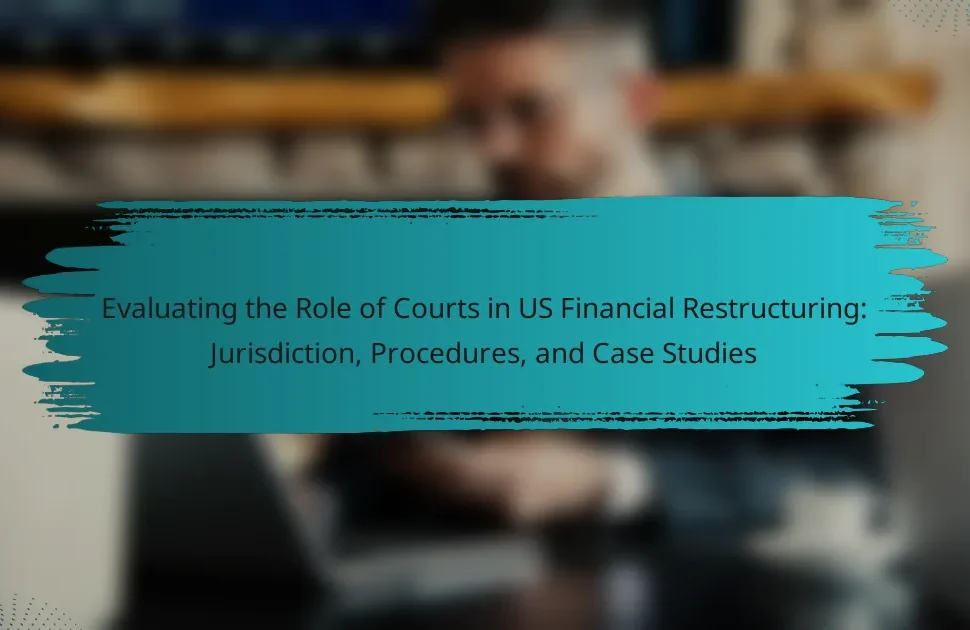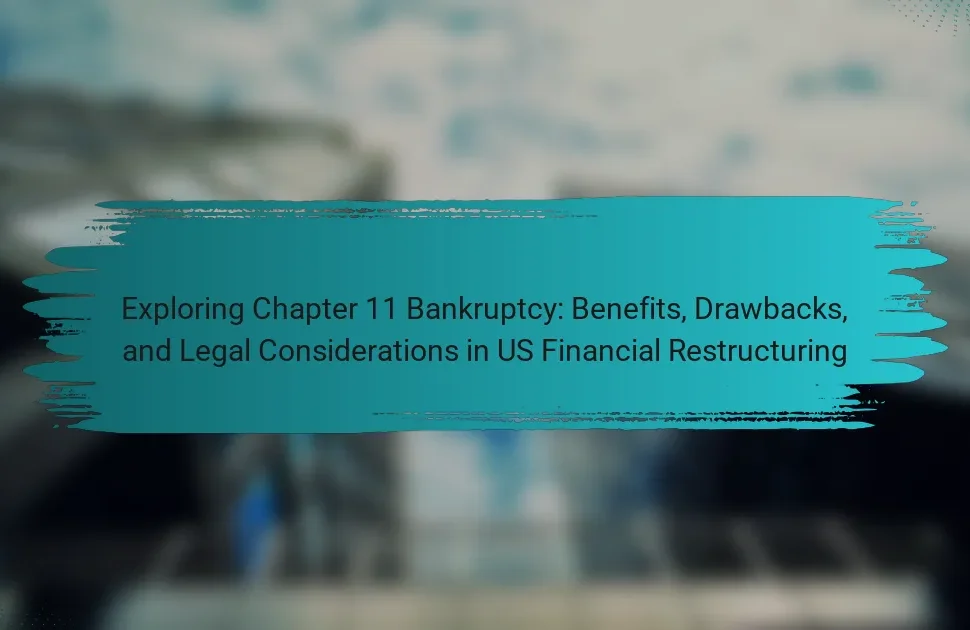Creditors are key participants in the financial restructuring process in the United States, holding claims against debtors and seeking to negotiate favorable terms for debt repayment or restructuring. Their influence is significant, as they possess voting power on proposed plans and can affect the outcome of negotiations. Creditors often aim to maximize their recovery on investments and may provide additional financing to assist debtors during restructuring. The strategies they employ in negotiations are critical to the success of the restructuring process, ultimately shaping the final agreement’s terms. This article examines the rights, claims, and negotiation strategies of creditors within the context of US financial restructuring.

What is the role of creditors in US financial restructuring?
Creditors play a crucial role in US financial restructuring. They hold claims against the debtor and have a vested interest in the outcome. Their primary function is to negotiate terms for debt repayment or restructuring. Creditors can influence the restructuring process through their voting power on proposed plans. They often seek to maximize recovery on their investments. Creditors may also provide additional financing to support the debtor during restructuring. The negotiation strategies employed by creditors can significantly impact the success of the restructuring. Ultimately, their involvement shapes the terms of the final restructuring agreement.
How do creditors influence the financial restructuring process?
Creditors influence the financial restructuring process by negotiating terms that affect the debtor’s financial obligations. Their claims often dictate the restructuring strategy. Creditors can propose debt reduction, extended payment terms, or conversion of debt to equity. These proposals can reshape the debtor’s capital structure. Additionally, creditors may demand specific operational changes as part of the restructuring agreement. Their voting power in bankruptcy proceedings can determine the outcome of proposed plans. The leverage creditors hold stems from their financial stake in the business. Research shows that creditor negotiations significantly impact recovery rates and overall restructuring success.
What types of creditors are involved in financial restructuring?
The types of creditors involved in financial restructuring include secured creditors, unsecured creditors, and subordinated creditors. Secured creditors hold collateral against the debt they are owed. This gives them priority in repayment during restructuring. Unsecured creditors do not have collateral backing their claims. They are typically lower in priority compared to secured creditors. Subordinated creditors have claims that are repaid after senior creditors. This makes their position riskier in restructuring scenarios. Each type of creditor plays a distinct role in the negotiation process. Their rights and claims significantly influence the outcome of financial restructuring efforts.
What are the primary rights of creditors during restructuring?
Creditors have several primary rights during restructuring. These rights include the right to receive information about the debtor’s financial status. Creditors can also negotiate the terms of the restructuring plan. They have the right to vote on the proposed plan, influencing its acceptance. Creditors may seek to enforce their security interests against collateral. They can object to the plan if it does not treat their claims fairly. Additionally, creditors have the right to participate in court proceedings related to the restructuring. These rights are protected under bankruptcy laws, ensuring creditors can advocate for their interests.
What claims do creditors have in financial restructuring?
Creditors have several claims in financial restructuring. These claims typically include secured claims, unsecured claims, and priority claims. Secured claims are backed by collateral, giving creditors a legal right to specific assets. Unsecured claims lack collateral, making recovery more uncertain. Priority claims are given precedence in the payment hierarchy during restructuring.
In bankruptcy proceedings, creditors can vote on restructuring plans. Their approval is crucial for plan confirmation. Additionally, creditors may negotiate for better terms, such as debt reductions or extended repayment periods. The Bankruptcy Code governs these claims and provides a framework for creditor rights.
Proof of these claims can be found in legal statutes, such as the U.S. Bankruptcy Code, which outlines the rights of different classes of creditors. Historical cases also demonstrate the influence of creditor claims on restructuring outcomes.
How are creditor claims prioritized in bankruptcy proceedings?
Creditor claims are prioritized in bankruptcy proceedings based on a specific hierarchy established by law. Secured creditors have the highest priority because their claims are backed by collateral. Unsecured creditors follow, which includes trade creditors and bondholders. Within unsecured claims, priority unsecured creditors, such as certain tax claims and employee wages, are prioritized over general unsecured creditors. This prioritization ensures that creditors are paid in a systematic order during the liquidation or reorganization of the debtor’s assets. The U.S. Bankruptcy Code outlines these priorities to provide a fair distribution of assets among creditors.
What factors determine the value of creditor claims?
The value of creditor claims is determined by several key factors. These factors include the priority of the claim, which dictates the order of payment in bankruptcy proceedings. Secured claims typically hold higher value due to collateral backing. Unsecured claims, lacking such collateral, are often valued lower.
Additionally, the financial condition of the debtor influences claim value. A solvent debtor may afford to pay more, enhancing claim value. Conversely, an insolvent debtor reduces potential recovery, lowering claim value.
Market conditions also play a role. Economic downturns may decrease asset values, negatively impacting claims. Conversely, a robust economy can enhance recovery prospects.
Negotiation strategies employed by creditors can further affect claim value. Strong negotiation can lead to better terms and higher recovery rates.
Lastly, legal frameworks and regulations governing bankruptcy influence claim valuation. Laws dictate how claims are treated and prioritized, affecting overall value.
What negotiation strategies can creditors employ during restructuring?
Creditors can employ several negotiation strategies during restructuring. They can prioritize debt recovery by negotiating payment terms. Creditors may also seek to convert debt into equity to gain ownership stakes. Offering concessions, such as reduced interest rates, can facilitate negotiations. Creditors can form committees to consolidate their interests and strengthen bargaining power. They may also utilize legal leverage by enforcing claims through bankruptcy proceedings. Additionally, creditors can propose alternative financing solutions to ensure liquidity. Engaging in open communication fosters trust and collaboration among stakeholders. These strategies enhance the likelihood of a successful restructuring outcome.
How can creditors effectively communicate their interests?
Creditors can effectively communicate their interests by clearly articulating their claims and expectations. They should prepare detailed documentation of their financial positions. This includes outlining the amounts owed and the terms of the agreements. Regular communication with debtors is essential for transparency. Creditors should engage in open dialogues during negotiations. Utilizing formal channels, such as letters or meetings, can enhance clarity. Active listening is also important to understand the debtor’s perspective. Maintaining professionalism throughout the process fosters constructive relationships. These strategies help ensure that creditors’ interests are recognized and addressed.
What role does negotiation play in achieving favorable outcomes for creditors?
Negotiation is crucial for creditors to achieve favorable outcomes. It allows creditors to advocate for their interests in financial restructuring. Effective negotiation can lead to better repayment terms and reduced losses. Creditors can leverage their positions to influence the restructuring process. By negotiating, they can secure priority claims and improved recovery rates. Historical examples show that creditors who negotiate effectively often fare better in bankruptcy proceedings. Additionally, successful negotiations can foster collaborative relationships with debtors, leading to mutually beneficial solutions.
How do creditor rights intersect with debtor obligations?
Creditor rights intersect with debtor obligations primarily through the legal framework governing debt relationships. Creditors have the right to receive payment according to the terms of the contract. Debtors, in turn, have an obligation to fulfill these payment terms. When a debtor defaults, creditor rights allow for legal actions to recover owed amounts. This can include filing claims in bankruptcy proceedings or pursuing collection efforts. The intersection is critical in financial restructuring scenarios. Creditors often negotiate with debtors to reach mutually beneficial agreements. These negotiations can lead to revised payment plans or debt forgiveness. In essence, the balance between creditor rights and debtor obligations shapes the dynamics of financial relationships.
What are the implications of creditor claims on the restructuring plan?
Creditor claims significantly influence the restructuring plan. They determine the feasibility and acceptance of the plan. Creditors may negotiate terms that directly affect repayment structures. Their claims can lead to prioritization of certain debts over others. This prioritization impacts the distribution of assets during the restructuring process. Furthermore, creditor objections can delay or derail the approval of the plan. In some cases, strong creditor claims can lead to a complete overhaul of the proposed restructuring strategy. Ultimately, the outcome hinges on the balance between creditor demands and the company’s operational viability.
What best practices should creditors follow during financial restructuring?
Creditors should prioritize open communication during financial restructuring. This fosters transparency and builds trust with the debtor. Establishing clear objectives is crucial for creditors. They need to define their goals regarding debt recovery and future relationships. Conducting thorough due diligence is essential. Creditors should assess the debtor’s financial status comprehensively. This includes analyzing cash flow, assets, and liabilities.
Creating a collaborative environment is beneficial. Creditors can work with debtors to explore viable restructuring options. Offering flexible terms may enhance recovery prospects. Creditors should also remain informed about legal rights and obligations. Understanding bankruptcy laws and creditor priorities is vital. Engaging in negotiations with a strategic approach can lead to favorable outcomes.
Monitoring the restructuring process is important. Creditors must track compliance with agreed-upon terms. This ensures that the debtor is adhering to the restructuring plan. Documenting all agreements and communications is essential for clarity. Clear records can prevent disputes in the future.
The main entity of the article is creditors in the context of US financial restructuring. The article provides a comprehensive overview of the crucial role creditors play, including their rights, types of claims, and negotiation strategies during the restructuring process. It details how creditors influence the outcome of restructuring plans through their voting power, the prioritization of claims, and the negotiation of terms that affect debtor obligations. Additionally, it highlights best practices for creditors to enhance recovery prospects and maintain effective communication with debtors throughout the process.




